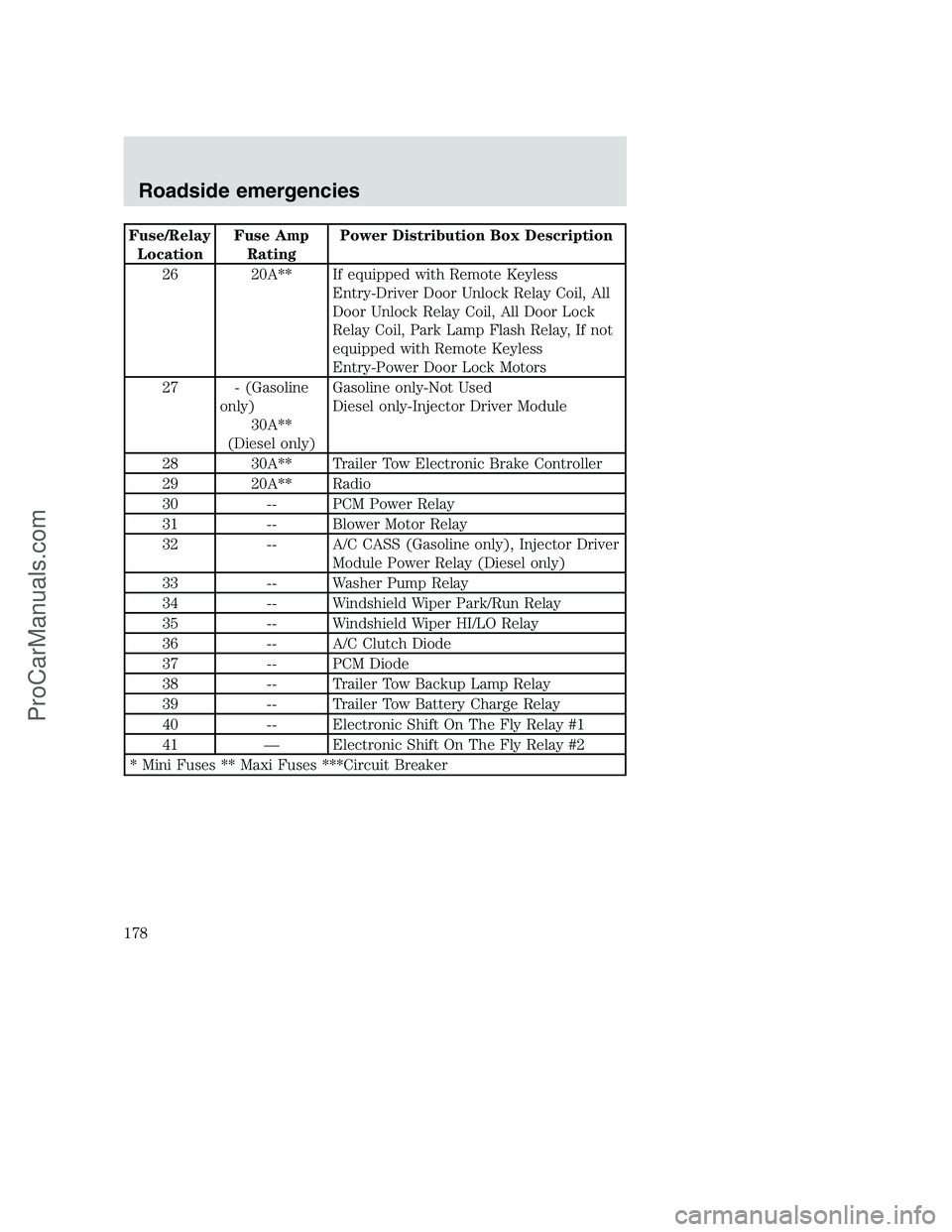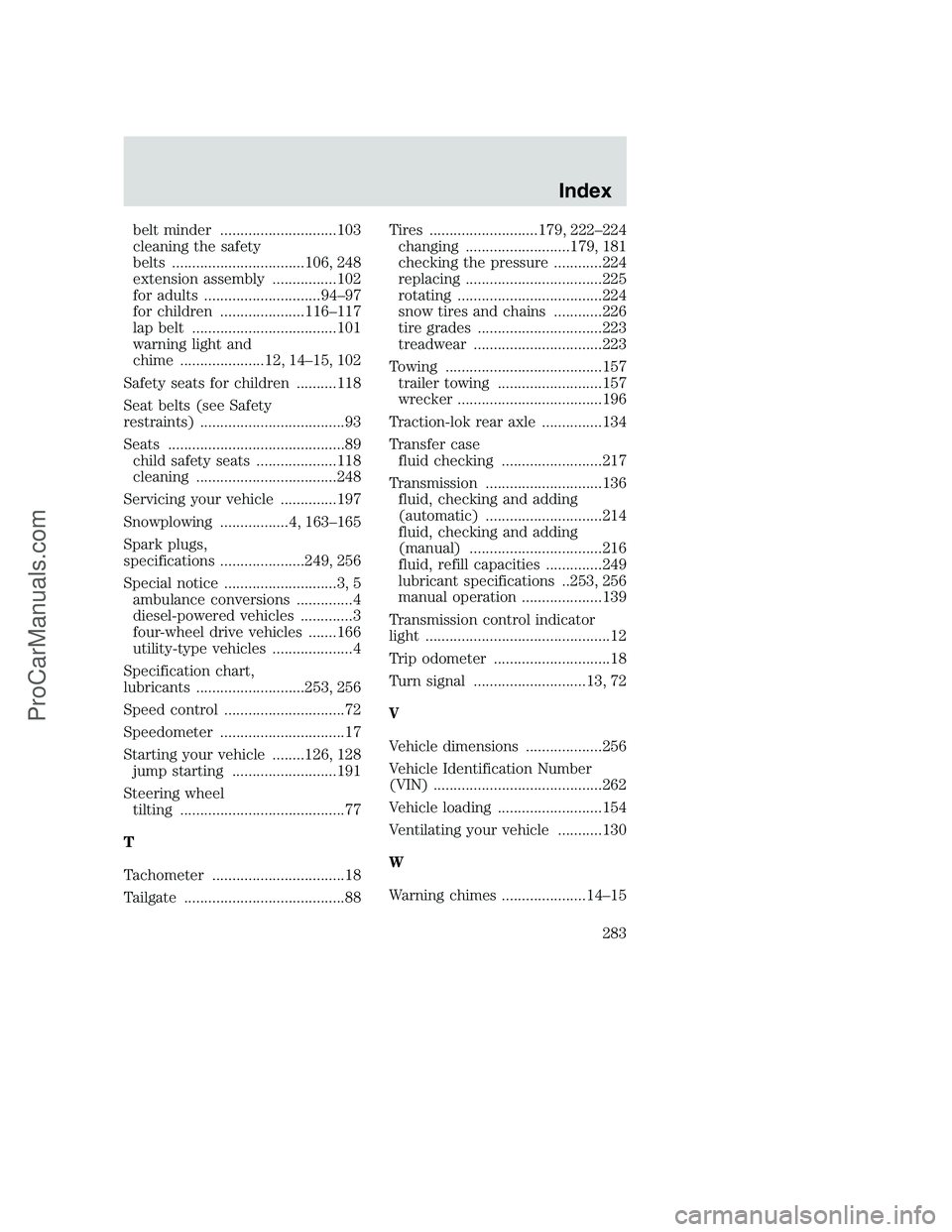2001 FORD F250 trailer
[x] Cancel search: trailerPage 178 of 288

Fuse/Relay
LocationFuse Amp
RatingPower Distribution Box Description
26 20A** If equipped with Remote Keyless
Entry-Driver Door Unlock Relay Coil, All
Door Unlock Relay Coil, All Door Lock
Relay Coil, Park Lamp Flash Relay, If not
equipped with Remote Keyless
Entry-Power Door Lock Motors
27 - (Gasoline
only)
30A**
(Diesel only)Gasoline only-Not Used
Diesel only-Injector Driver Module
28 30A** Trailer Tow Electronic Brake Controller
29 20A** Radio
30 -- PCM Power Relay
31 -- Blower Motor Relay
32 -- A/C CASS (Gasoline only), Injector Driver
Module Power Relay (Diesel only)
33 -- Washer Pump Relay
34 -- Windshield Wiper Park/Run Relay
35 -- Windshield Wiper HI/LO Relay
36 -- A/C Clutch Diode
37 -- PCM Diode
38 -- Trailer Tow Backup Lamp Relay
39 -- Trailer Tow Battery Charge Relay
40 -- Electronic Shift On The Fly Relay #1
41 — Electronic Shift On The Fly Relay #2
* Mini Fuses ** Maxi Fuses ***Circuit Breaker
Roadside emergencies
178
ProCarManuals.com
Page 214 of 288

TRANSMISSION FLUID
Checking automatic transmission fluid (if equipped)
Refer to your scheduled maintenance guide for scheduled intervals for
fluid checks and changes. Your transmission does not consume fluid.
However, the fluid level should be checked if the transmission is not
working properly, i.e., if the transmission slips or shifts slowly or if you
notice some sign of fluid leakage.
Automatic transmission fluid expands when warmed. To obtain an
accurate fluid check, drive the vehicle until it is at normal operating
temperature (approximately 30 km [20 miles]). If your vehicle has been
operated for an extended period at high speeds, in city traffic during hot
weather or pulling a trailer, the vehicle should be turned off for about 30
minutes to allow fluid to cool before checking.
1. Drive the vehicle 30 km (20 miles) or until it reaches normal operating
temperature.
2. Park the vehicle on a level surface and engage the parking brake.
3. With the parking brake engaged and your foot on the brake pedal,
start the engine and move the gearshift lever through all of the gear
ranges. Allow sufficient time for each gear to engage.
4. Latch the gearshift lever in P (Park) and leave the engine running.
5. Remove the dipstick, wiping it clean with a clean, dry lint free rag. If
necessary, refer toIdentifying components in the engine compartment
in this chapter for the location of the dipstick.
6. Install the dipstick making sure it is fully seated in the filler tube.
7. Remove the dipstick and inspect the fluid level. The fluid should be in
the designated area for normal operating temperature or ambient
temperature.
Low fluid level
Do not drive the vehicle if the fluid
level is at the bottom of the dipstick
and the ambient temperature is
above 10°C (50°F).
ADD COLD HOT DO NOT ADD
DON'T ADD IF IN CROSSHATCHED AREA CHECK WHEN HOT IDLING IN PARK
Maintenance and care
214
ProCarManuals.com
Page 234 of 288
![FORD F250 2001 Owners Manual •Driving at reasonable speeds (traveling at 88 km/h [55 mph] uses 15%
less fuel than traveling at 105 km/h [65 mph]).
•Revving the engine before turning it off may reduce fuel economy.
•Using th FORD F250 2001 Owners Manual •Driving at reasonable speeds (traveling at 88 km/h [55 mph] uses 15%
less fuel than traveling at 105 km/h [65 mph]).
•Revving the engine before turning it off may reduce fuel economy.
•Using th](/manual-img/11/57804/w960_57804-233.png)
•Driving at reasonable speeds (traveling at 88 km/h [55 mph] uses 15%
less fuel than traveling at 105 km/h [65 mph]).
•Revving the engine before turning it off may reduce fuel economy.
•Using the air conditioner or defroster may reduce fuel economy.
•You may want to turn off the speed control in hilly terrain if
unnecessary shifting between third and fourth gear occurs.
Unnecessary shifting of this type could result in reduced fuel
economy.
•Warming up a vehicle on cold mornings is not required and may
reduce fuel economy.
•Resting your foot on the brake pedal while driving may reduce fuel
economy.
•Combine errands and minimize stop-and-go driving.
Maintenance
•Keep tires properly inflated and use only recommended size.
•Operating a vehicle with the wheels out of alignment will reduce fuel
economy.
•Perform all regularly scheduled maintenance items. Follow the
recommended maintenance schedule and owner maintenance checks
found in your vehicle scheduled maintenance guide.
Conditions
•Heavily loading a vehicle or towing a trailer may reduce fuel economy
at any speed.
•Carrying unnecessary weight may reduce fuel economy (approximately
0.4 km/L [1 mpg] is lost for every 180 kg [400 lb] of weight carried).
•Adding certain accessories to your vehicle (for example bug
deflectors, rollbars/light bars, running boards, ski/luggage racks) may
reduce fuel economy.
•Using fuel blended with alcohol may lower fuel economy.
•Fuel economy may decrease with lower temperatures during the first
12–16 km (8–10 miles) of driving.
•Driving on flat terrain offers improved fuel economy as compared to
driving on hilly terrain.
Maintenance and care
234
ProCarManuals.com
Page 272 of 288

Comfort and convenience
Air conditioner
Cargo organizers
Cargo storage bin
Cargo trays
Engine block heaters
Manual sliding rear window
Power sliding rear window
Tire step
Travel equipment
Auto headlamp system with Daytime Running Lights (DRL)
Bed Tent
Bumper mounted bike courier
Daytime running lights (DRL)
Electrochromic inside mirror with compass
Electrochromic inside mirror with compass and temperature display
Fog lights
Heavy-duty battery
Home link with travel note sun visor
Off road lights
Pickup box rails
Running boards and tubular running bars
Running boards diamond plate
Seatback organizer
Speed control
Towing mirrors
Trailer hitch, Class IV
Trailer hitch bars and balls
Trailer hitch mounted bike carrier
Trailer hitch wiring adaptor
Trailer wiring harness
Customer assistance
272
ProCarManuals.com
Page 282 of 288

safety belt .................................12
service engine soon ..................10
speed control ............................76
turn signal indicator .................13
Load limits .................................154
GAWR ......................................154
GVWR ......................................154
trailer towing ..........................154
Loading instructions .................155
Locks
childproof ..................................81
Lubricant specifications ...253, 256
Lumbar support, seats .........91–92
M
Manual transmission .................139
fluid capacities ........................249
lubricant specifications ..........256
reverse .....................................143
Message center ...........................19
english/metric button ...............20
menu button .............................20
Mirrors .........................................83
fold away ...................................82
heated ........................................83
side view mirrors (power) .......81
Motorcraft parts ................231, 249
O
Octane rating ............................229
Odometer .....................................18
Oil (see Engine oil) ..................201
Overdrive .....................................78P
Panic alarm feature, remote
entry system ................................85
Parking brake ............................133
Parts (see Motorcraft parts) ....249
Pedals (see Power adjustable
foot pedals) .................................26
Power distribution box
(see Fuses) ...............................175
Power door locks ........................80
Power steering ..........................134
fluid, checking and adding ....213
fluid, refill capacity ................249
fluid, specifications .........253, 256
Preparing to drive your
vehicle ........................................135
R
Radio ............................................35
Relays ........................................170
Remote entry system ...........84–85
illuminated entry ......................86
locking/unlocking doors ...........85
panic alarm ...............................85
replacement/additional
transmitters ...............................87
replacing the batteries .............86
Reverse sensing system .............27
S
Safety belts (see Safety
restraints) ..................15, 93–97, 99
Safety defects, reporting ..........277
Safety restraints ..............93–97, 99
Index
282
ProCarManuals.com
Page 283 of 288

belt minder .............................103
cleaning the safety
belts .................................106, 248
extension assembly ................102
for adults .............................94–97
for children .....................116–117
lap belt ....................................101
warning light and
chime .....................12, 14–15, 102
Safety seats for children ..........118
Seat belts (see Safety
restraints) ....................................93
Seats ............................................89
child safety seats ....................118
cleaning ...................................248
Servicing your vehicle ..............197
Snowplowing .................4, 163–165
Spark plugs,
specifications .....................249, 256
Special notice ............................3, 5
ambulance conversions ..............4
diesel-powered vehicles .............3
four-wheel drive vehicles .......166
utility-type vehicles ....................4
Specification chart,
lubricants ...........................253, 256
Speed control ..............................72
Speedometer ...............................17
Starting your vehicle ........126, 128
jump starting ..........................191
Steering wheel
tilting .........................................77
T
Tachometer .................................18
Tailgate ........................................88Tires ...........................179, 222–224
changing ..........................179, 181
checking the pressure ............224
replacing ..................................225
rotating ....................................224
snow tires and chains ............226
tire grades ...............................223
treadwear ................................223
Towing .......................................157
trailer towing ..........................157
wrecker ....................................196
Traction-lok rear axle ...............134
Transfer case
fluid checking .........................217
Transmission .............................136
fluid, checking and adding
(automatic) .............................214
fluid, checking and adding
(manual) .................................216
fluid, refill capacities ..............249
lubricant specifications ..253, 256
manual operation ....................139
Transmission control indicator
light ..............................................12
Trip odometer .............................18
Turn signal ............................13, 72
V
Vehicle dimensions ...................256
Vehicle Identification Number
(VIN) ..........................................262
Vehicle loading ..........................154
Ventilating your vehicle ...........130
W
Warning chimes .....................14–15
Index
283
ProCarManuals.com